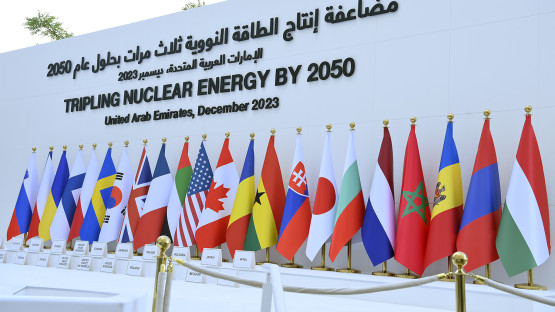Nuclear Energy’s Role in Tackling Climate Change: From Dubai to Baku
As the world continues to grapple with the pressing issues of climate change and energy sustainability, nuclear energy has emerged as a pivotal player in this global narrative. The past year has been monumental for the nuclear power sector, marking a significant shift in international efforts to utilize this clean and reliable technology to address some of the world’s most pressing climate and energy challenges. This shift is moving from the 28th session of the Conference of the Parties (COP28) held in Dubai to COP29 in Baku, Azerbaijan, where the annual global climate summit is set to take place.
Recognition at COP28
The COP28 conference was a landmark event for the nuclear energy industry. After nearly three decades of being sidelined at these annual conferences, nuclear energy received its deserved acknowledgment in Dubai. It was clearly articulated during COP28 that expanding the use of nuclear energy must become a central component of global efforts to achieve carbon neutrality. This recognition has set the stage for further discussions and initiatives as the world looks towards a future with reduced carbon emissions.
Momentum in Brussels and Baku
The momentum gained at COP28 was further fueled by the first Nuclear Energy Summit, organized by the International Atomic Energy Agency (IAEA) and the Government of Belgium, held in March 2024 in Brussels. Leaders from over 30 countries and the European Union underscored the critical role of nuclear energy in ensuring energy security, meeting climate goals, and fostering sustainable development. As COP29 approaches, nuclear energy is once again at the forefront, with countries outlining pathways to harness its full potential.
Diversifying Nuclear Energy Solutions
To triple nuclear power capacity by 2050, the global community needs to leverage all available solutions. Nearly all of the approximately 60 reactors currently under construction are large pressurized water reactors. While these technologies will be the primary driver of industry growth, advanced technologies such as small modular reactors (SMRs) and microreactors, including new designs with innovative fuels and coolants, will also play a significant role.
Nuclear energy is diverse in its applications. Besides providing baseload power for global electric grids, it can be used to rapidly decarbonize and mitigate the industrial sector’s impact, which is responsible for nearly 40% of greenhouse gas emissions. In the coming years, the demand for electricity from data centers and artificial intelligence projects is expected to grow rapidly. In response, companies like Google and Microsoft are actively exploring advanced nuclear technologies as clean, reliable, and flexible energy sources to meet their increasing needs. This exploration could open new commercial avenues for advanced nuclear energy in markets that have been difficult to penetrate due to financing challenges associated with innovative technologies.
Key Milestones on the Horizon
An increasing number of countries are seeking to integrate nuclear energy into their energy production structures. To meet these needs, the IAEA provides a clear framework for developing the necessary infrastructure to implement nuclear programs while adhering to nuclear safety, security, and environmental protection requirements. This framework has been updated to reflect the specifics of SMRs. As interest in nuclear energy grows in developing countries, all newcomer nations have the opportunity to benefit from the IAEA’s guidance.
Countries require support in developing their unique programs to achieve carbon neutrality. A common starting point is modeling energy scenarios, which provides a comprehensive, data-driven picture of the challenges and opportunities ahead. Through the IAEA’s Atoms4NetZero initiative, leaders and organizations receive the data needed to make informed, scientifically grounded decisions that fully leverage nuclear energy’s potential, including in non-electricity-generating areas, to decarbonize their economies.
Progress Across Various Fronts
Optimizing plans for expanding the energy system requires innovative approaches to constructing new nuclear power plants within time and budget constraints. The IAEA’s initiative on harmonization and standardization in the nuclear field helps countries develop coherent regulatory approaches and ensure industrial standardization to facilitate the deployment of SMRs and other advanced reactors that meet nuclear and physical safety requirements.
There is an unprecedented need for skilled personnel from diverse social and ethnic backgrounds who can meet the challenges of our time and ensure the long-term sustainability of nuclear energy. The IAEA supports countries in this area through initiatives like the Nuclear Energy Management School, the Marie Sklodowska-Curie Fellowship Programme, the Lise Meitner Programme, and a range of other educational programs, workshops, and independent evaluation services.
The IAEA conducts verification checks to ensure the peaceful use of nuclear materials. The ongoing expansion of nuclear power capacities leads to a continued increase in the quantity of nuclear materials used and the number of nuclear facilities under IAEA safeguards. The IAEA employs advanced technologies and collaborates with countries expanding their nuclear energy capacities, as well as newcomer countries seeking to incorporate nuclear energy into their energy production structures. As a result, the Agency is always ready to extend its guarantees to new materials and installations, thereby meeting the international community’s growing needs as the world moves towards carbon neutrality.
As the outcomes of COP28 have shown, the global demand for clean nuclear energy, which is characterized by a high level of reliability, continues to grow. At COP29, countries will have the opportunity to work towards ensuring the most effective use of nuclear energy’s capabilities—an essential component of a carbon-free future.
Additional Resources
For those interested in delving deeper into the topics discussed, the following resources may be of interest:
- Exploring Climate Change Solutions: IAEA and the Conference of the Parties – Visit Here
- Climate Change – Learn More
Related Stories
- New studies reveal that nuclear energy could help mitigate climate change impacts in some countries. – Read More
- The 2023 IAEA Scientific Forum: Nuclear Innovations for a Zero-Emission World – Read More
- A Milestone Moment: The First-Ever Nuclear Energy Summit Concludes in Brussels – Read More
- Belgian Prime Minister Alexander De Croo: "The Path to a Zero-Emission World Starts Here" – Read More
This article offers a comprehensive overview of the current and future role of nuclear energy in addressing global climate challenges and the concerted international efforts to harness its potential for a sustainable future.
For more Information, Refer to this article.
































